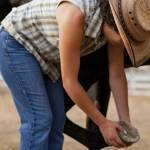A Tool to Test for Hoof Pain in Horses

Veterinarians and farriers often carry a tool that looks like a long-handled pincer with flat or rounded tips. This is a hoof tester, a device that can be used to apply gentle pressure to any spot on the horse’s sole, toe, or heel area.
For a horse that’s just a little bit “off” in its stride, the hoof tester will usually help in locating the source of the pain. A horse that’s “three-legged lame” from a suspected hoof abscess will flinch when the hoof tester is applied over the infected spot. If a shoeing nail has been driven into sensitive tissue, the hoof tester can help to identify the bad nail, and there are plenty of other ways to use the device in diagnosing hoof pain.
Horses react differently to pressure from a hoof tester. Some will flinch no matter where the tester is applied; others won’t show much reaction, even when the owner has reason to think the horse is in pain. In skilled hands, however, testers can reveal a lot about a horse’s pain level, the site of pain, and what hidden structures are involved. Getting rid of the discomfort may involve cutting into an abscess to relieve the pressure, changing the type or set of the shoes the horse is wearing, backing off on a horse’s training schedule, or use of anti-inflammatory medication.
So, should you run out to the farrier supply store, pick up a hoof tester, and try it out at home? Unless you are trained in the tool’s use, the answer is an emphatic “no.” While a hoof tester is a useful diagnostic tool, it can also cause intense pain and permanent injury if it is used too strongly or in a particularly sensitive spot. Some horses react violently to even moderate pressure, putting both the horse and its handler in serious danger of injury.
However, horse owners should have an idea of how their individual horses react to hoof testers when they are sound and in regular use. Asking a veterinarian or farrier to demonstrate the use of this tool is a good way for the owner to gauge the baseline sensitivity of a particular horse. The demonstration might, of course, turn up an unknown problem in its early stages, allowing treatment to begin before the condition becomes more serious.








